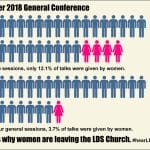
Join us and amplify women’s voices! Include two extra quotes from women in your Come Follow Me Lesson this week and . . .
- help women feel comfortable sharing their thoughts in your class
- show women their experiences and perspectives are important to you
- increase participation from diverse members who may not “fit the mold”
- overcome stereotypes about women and diversity
Join us in amplifying women’s voices by choosing to add just two extra quotes from women in your Come Follow Me lesson this week. It’s easy to include more women’s voices using the Sunday School, Young Women, Relief Society, or Primary lesson ideas from Exponent II below:
LDS Lesson Plans to help you include women’s perspectives from Exponent II
How can I encourage more women to speak in my Come Follow Me Lesson THIS WEEK?

Here are three easy ways to increase women’s participation in your lesson:
1) Amplify. Include two extra quotes from women using the Exponent II lesson plans or another source in your lesson.
2) Explore. If one woman shares a thought that seems to go unnoticed, bring the conversation back to her contribution. For example, “Jenny had an important thought; I’d like to explore it further.”1
3) Count Heads. Pay attention to the number of men and women in your classroom. Studies show women are less likely to speak when they are outnumbered.2 Use lesson techniques that can help you call on women to speak when they are in a group where gender dynamics make it harder for women to speak and be heard.
4) Read the Room. Pay attention to the expressions on women’s faces. Are they interested, concerned, confused, angry, happy, crying, or laughing? Based on that nonverbal feedback, you might change your approach, apologize, call on someone, or speak to someone after class.3
Why is it so important to add more women’s voices to my lessons?

BYU researchers have spent “years spent analyzing lab and real-life settings to determine what it takes for a woman to really be heard—to truly be perceived as competent and influential—these professors have found the same truth: for women, having a seat at the table does not mean having a voice.4
“Women are systematically seen as less authoritative,” says Preece. “And their influence is systematically lower. And [women are] speaking less. And when they are speaking up, they’re not being listened to as much, and they are being interrupted more.“
However inadvertent, the gender dynamics shutting women down are real, says Preece. Rather than outright misogyny, she says it’s usually cultural norms and gendered messages that subtly—and profoundly—shape the rules of engagement. Individuals who suppress female speech may do so unwittingly. “They may love women,” says Preece. “They may even be a woman!” But as a society we have been “slowly socialized over years to discount” female expertise and perspectives. The problem, in part, could be you.5
When you work to include just two more women’s voices in your Come Follow Me Lesson this week, you’re helping correct the imbalance that can occur where women speak less, are interrupted more, are seen as less authoritative, and have their experiences discounted.
What are some other resources I can use to increase women’s participation?

Learn more about gender dynamics from BYU researcher’s book The Silent Sex: Gender, Deliberation, and Institutions: https://www.amazon.com/Silent-Sex-Gender-Deliberation-Institutions/dp/0691159769
Dialogue: A Journal of Mormon Thought has a podcast that features many women’s voices speaking on the Come Follow Me Lesson this week: https://www.dialoguejournal.com/podcast-subjects/gospel-study/
Tips for helping reluctant students speak up: https://www.greatbooks.org/help-reluctant-students-speak-up/
Edutopia’s tips for encouraging student participation: https://www.edutopia.org/article/encouraging-shy-students-speak-class/
Footnotes
- “Why and how to amplify women’s voices,” Farmer’s Survival Guide for Women. https://farmerssurvivalguide.com/why-and-how-to-amplify-womens-voices/ ↩︎
- “Women Speak Up Less When They’re Outnumbered,” https://magazine.byu.edu/article/women-speak-up-less-when-theyre-outnumbered/ ↩︎
- “How Allies Can Amplify the Voices of Women: Tips from Liberty Mutual’s Livio R. Perez,” https://www.txconferenceforwomen.org/how-allies-can-amplify-the-voices-of-women/ ↩︎
- “Women Speak Up Less When They’re Outnumbered,” https://magazine.byu.edu/article/women-speak-up-less-when-theyre-outnumbered/ ↩︎
- “When Women Don’t Speak,” Brittany Karford Rogers, BYU Magazine, Spring 2020, https://magazine.byu.edu/article/when-women-dont-speak/ ↩︎















